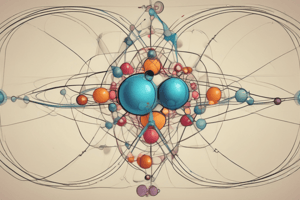Podcast
Questions and Answers
Elektron bertanggung jawab atas sebagian besar ______ atom
Elektron bertanggung jawab atas sebagian besar ______ atom
volume
Orbital dapat berupa s, p, d, atau f, tergantung pada bentuk dan ______ orbital
Orbital dapat berupa s, p, d, atau f, tergantung pada bentuk dan ______ orbital
energi
Elektron didistribusikan dalam orbital atom, yang dapat dianggap sebagai wilayah di ruang di mana elektron paling mungkin ______ ditemukan
Elektron didistribusikan dalam orbital atom, yang dapat dianggap sebagai wilayah di ruang di mana elektron paling mungkin ______ ditemukan
akan
Kerangkaian elektron dalam atom mewakili penataan elektron dalam ______ atom
Kerangkaian elektron dalam atom mewakili penataan elektron dalam ______ atom
Elektron diatur ke dalam kulit elektron, masing-masing dengan tingkat ______ tertentu
Elektron diatur ke dalam kulit elektron, masing-masing dengan tingkat ______ tertentu
Prinsip ______: Prinsip ini menyatakan bahwa elektron harus diisi sesuai urutan energi yang meningkat. Orbital energi rendah harus diisi terlebih dahulu, dan level energi yang lebih tinggi harus mengikuti.
Prinsip ______: Prinsip ini menyatakan bahwa elektron harus diisi sesuai urutan energi yang meningkat. Orbital energi rendah harus diisi terlebih dahulu, dan level energi yang lebih tinggi harus mengikuti.
Model ______: Dalam model ini, elektron bergerak dalam orbit atau tingkat energi tertentu di sekitar inti. Elektron dapat berpindah dari satu orbit ke orbit lain, menyerap atau melepaskan jumlah energi tertentu dalam prosesnya.
Model ______: Dalam model ini, elektron bergerak dalam orbit atau tingkat energi tertentu di sekitar inti. Elektron dapat berpindah dari satu orbit ke orbit lain, menyerap atau melepaskan jumlah energi tertentu dalam prosesnya.
Prinsip ______ Pauli: Prinsip ini menyatakan bahwa tidak ada dua elektron yang dapat memiliki set yang sama dari empat bilangan kuantum. Akibatnya, setiap orbital dapat menampung maksimum dua elektron, dan kedua elektron dalam orbital yang diberikan harus memiliki spin yang sama.
Prinsip ______ Pauli: Prinsip ini menyatakan bahwa tidak ada dua elektron yang dapat memiliki set yang sama dari empat bilangan kuantum. Akibatnya, setiap orbital dapat menampung maksimum dua elektron, dan kedua elektron dalam orbital yang diberikan harus memiliki spin yang sama.
Konfigurasi ______ elektron: Notasi ini mewakili susunan elektron dalam orbital atom. Sebagai contoh, konfigurasi elektron natrium adalah 1s²2s²p63s¹.
Konfigurasi ______ elektron: Notasi ini mewakili susunan elektron dalam orbital atom. Sebagai contoh, konfigurasi elektron natrium adalah 1s²2s²p63s¹.
Aturan ______ Hund tentang Kelipatan Maksimum: Dalam kasus orbital degeneratif (energi yang sama), semua orbital degeneratif harus diisi secara tunggal terlebih dahulu, dan kemudian hanya pasangan diizinkan.
Aturan ______ Hund tentang Kelipatan Maksimum: Dalam kasus orbital degeneratif (energi yang sama), semua orbital degeneratif harus diisi secara tunggal terlebih dahulu, dan kemudian hanya pasangan diizinkan.
Flashcards are hidden until you start studying
Study Notes
Atom: Electron Configuration and Atomic Structure
The atom is the basic building block of all matter and chemistry, consisting of a nucleus and a cloud of electrons surrounding it. The nucleus contains protons and neutrons, while electrons are responsible for most of an atom's volume. Understanding the electron configuration and atomic structure of an atom is crucial for comprehending the properties and chemical behavior of elements.
Electron Configuration
The electron configuration of an atom represents the arrangement of electrons in its orbitals. Electrons are distributed in atomic orbitals, which can be thought of as regions in space where electrons are most likely to be found. These orbitals come in different shapes and sizes, and electrons occupy them according to certain rules.
Some key aspects of electron configuration include:
-
Atomic Orbitals: These are the wavefunctions of electrons and the energies associated with them. Orbitals can be thought of as regions in space where electrons are most likely to be found.
-
Electron Shells: Electrons are organized into electron shells, each with a specific energy level. The shells are labeled with the letters K, L, M, N, O, P, and Q, with K being the closest to the nucleus and Q being the farthest.
-
Orbitals: Orbitals can be s, p, d, or f, depending on the shape and energy of the orbital.
-
Electronic Configuration Notation: This notation represents the arrangement of electrons in an atom's orbitals. For example, the electronic configuration of sodium is 1s²2s²p63s¹.
Atomic Structure
The atomic structure of an element is determined by the arrangement of its electrons in atomic orbitals. The structure can be described using models such as the Bohr model, which represents electrons orbiting the nucleus of an atom. Some key aspects of atomic structure include:
-
Bohr Model: In this model, electrons move in specific orbits or energy levels around the nucleus. Electrons can move from one orbit to another, absorbing or releasing specific amounts of energy in the process.
-
Aufbau's Principle: This principle states that electrons should be filled in the order of increasing energy. Lower energy orbitals should be filled first, and higher energy levels should follow.
-
Pauli's Exclusion Principle: This principle states that no two electrons can have the same set of four quantum numbers. Consequently, each orbital can hold a maximum of two electrons, and both electrons in a given orbital must have the same spin.
-
Hund's Rule of Maximum Multiplicity: In the case of degenerate (same energy) orbitals, all the degenerate orbitals must be singly filled first, and then only pairing is allowed.
Understanding the electron configuration and atomic structure of an atom is essential for explaining the properties and chemical behavior of elements. These concepts form the foundation of modern atomic theory and are crucial for understanding the behavior of elements in various chemical reactions and processes.
Studying That Suits You
Use AI to generate personalized quizzes and flashcards to suit your learning preferences.




